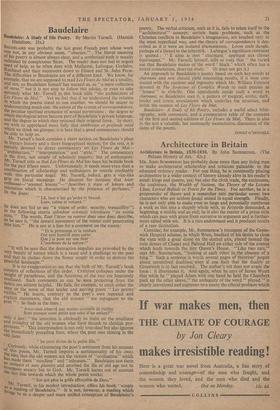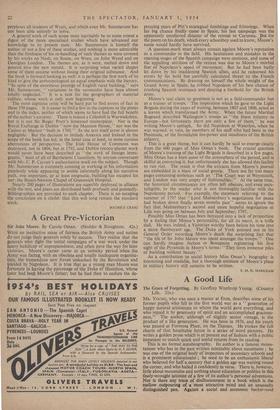Architecture in Britain
MR. JOHN SUMMERSON has probably done more than any living man to make architectural scholarship and criticism palatable to the educated ordinary reader. For one thing, he is continually placing architecture in a wider context of history already alive in his reader's mind: kings and queens, yes; but also the cloth trade, the enclosures, the coalmines, the Wealth of Nations, the Theory of the Leisure Class, Lyrical Ballads or Tracts for the Times. For another, he is a propounder of theses and a researcher into particular cases: two characters who arc seldom found united in equal strength. Finally, he is not only able to make even so large and potentially cumbrous a work as this into a shapely whole with, as Aristotle demanded, a beginning, a middle and an end; he is also the master of a prose style which can pass with grace from narrative to argument and is further- more salted with wit. It is a rare endowment and it produces results of a rare distinction. perplexes all students of Wyatt, and which even Mr. Summerson has not been able entirely to solve.
A general work of such scope must inevitably be to some extent a digest of the more specialised studies which have advanced our knowledge to its present state. Mr. Summerson is himself the author of not a few of these studies, and nothing is more admirable than the freshness of his re-handling of such themes as were covered by his works on Nash, on Soane, on Wren, on John Wood and on Georgian London. The themes are, as it were, melted down and poured into the new mould. It is surprising what varied shapes some of them assume without losing their original substance. And the book is forward-looking as well: it is perhaps the first work of its kind to give the anthropological an equal emphasis with the literary. "In spite of the enormous prestige of English rural building," says Mr. Summerson, " variations in the vernacular have been almost totally neglected." It is a task for the geographers of material culture, whose work is only now beginning.
The most captious critic will be hard put to find errors of fact in these 350 pages. It is easier to find a few in the captions to the plates and in the index, neither of which seems to have had the full benefit of the author's scrutiny. There is indeed a Coleshill in Warwickshire, but it is not Sir Roger Pratt's lamented masterpiece. Nor is the Royal Exchange in Dublin "now the Mansion House," nor was the Casino at Marino "built in 1769." In the text itself error is almost negligible. But the decision to include America and Ireland in the scope of the book has led, in the latter' case at least, to some curious aberrations of perspective. The Irish House of Commons was destroyed, not in 1804, but in 1792, and Dublin rococo plaster work would never have been described as "the work of foreign immi- grants," least of all of Barthelemi Cramillion, by anyone conversant with Mr. C. P. Curran's authoritative work on the subject. Though Mr. Summerson is extremely cunning in working in his information painlessly while appearing to amble informally along his narrative path, one important, or at least enigmatic, building has escaped his net: the Stuart-Newton Chapel of Greenwich Hospital.
Nearly 200 pages of illustrations are superbly deployed in alliance with the text, and plans are distributed both profusely and pointedly. Bibliographies are provided to each chapter. There is no escaping the conclusion on a cliché: that this will long remain the standard work.
MAURICE CRAIG











































 Previous page
Previous page